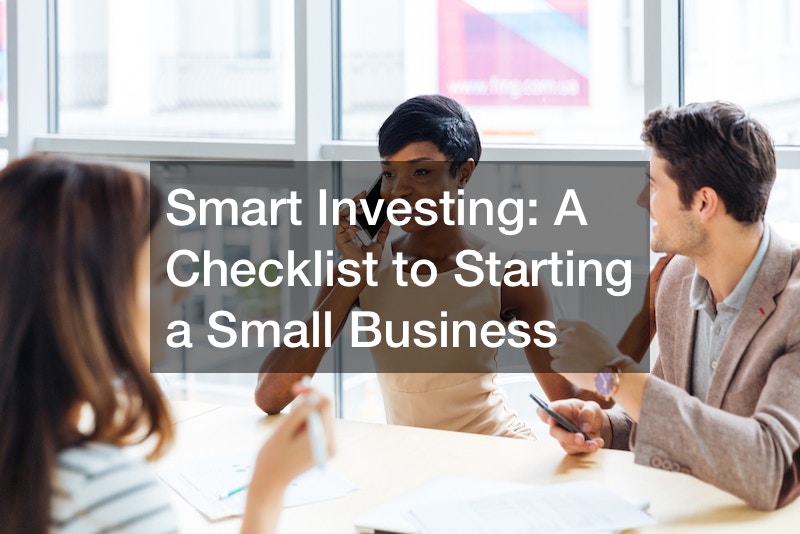
Do you want to start a business but are not sure where to start? You’ve come to the right place. This article is a checklist to starting a small business. These are some of the essential requirements you’ll have to meet as you start your business.
Validate Your Business Idea
Smart investing means investing in a business that will give you guaranteed returns. As such, you should only sell a product or service that has a market, and the demand is reasonably high to give you meaningful returns.
The best way to find out about the potential of your business idea is by conducting market research. Try to find out if the product is needed, who are the likely buyers, and how they want the finished product packaged or delivered. You should also start thinking of a good business name.
After validating your idea, you should create a business plan. The plan will outline key elements of the business, including the structure and how it will operate. If you plan to have a physical store, you’ll need a good storefront.
The Storefront

Unless you plan to wholly operate online, you’ll need a strategically located store to actualize your dream of owning a business. Even if you have an online store, you stand to benefit if you have a brick-and-mortar store that is easy to access. One of the most important parts of the store is its front, and you’ll have to invest in it to give customers a good impression of your business.
You may have identified a store for the business but it doesn’t have a storefront. It may have a storefront, but the storefront was designed for a different type of business. For example, you may be planning to start a clothes store but the existing storefront was designed for a grocery shop. To give the storefront a new look that fits your business, you’ll have to hire a commercial construction contractor.
The storefront is supposed to welcome customers into your shop. People should be able to tell what you’re selling just by looking at the storefront. You may have to include display windows that showcase your products. Potential buyers will also be able to handle the inventory in person. Ensure that everything goes right with the design of the storefront because it’s the first impression of your brand from the sidewalk or street.
Choose a Legal Structure
A storefront is only applicable to physical stores. Some entrepreneurs may opt to sell exclusively online. This takes a different structure and mode of operation of the business. More importantly, choose a specific legal structure you want to use, whether you’re online or offline. Are you going solo and want to be a sole proprietor? Or you’re going with the limited liability option. The legal structure will determine how you pay taxes and the regulations you should follow.
You should also register your business with the relevant authorities. For specific types of businesses or services, you may have to register with more than one authority. Furthermore, you may need to register your business with industry-specific professional agencies or bodies.
Furnishing and Amenities
Your store should have the right furnishings or furniture to make it a suitable environment for the specific type of products you’re selling. For example, some businesses may need stores with specific types of shelves for storing and displaying merchandise. Some renovation may be necessary to include these shelves. Use self storage rentals to temporarily store your furniture and other items as you do the renovations.
This checklist to starting a small business also highlights the type of amenities that are necessary to comfortably operate your small business. Some important amenities to look out for include a car parking space for your customers, washrooms, fast and reliable Wi-Fi, and security measures.
You will need different types of furniture for a variety of needs. For example, you may need a workstation or space for your computer. To get the best deal, compare prices from different furniture stores before buying.
Business Infrastructure

Business infrastructure is one of the most essential components of any business. This checklist to starting a small business, therefore, ranks this among the essentials for small businesses. One of the key infrastructures you’d want to set up is your business computing infrastructure. This would include proper set up of your computers, networking of the computers, and connection to reliable internet.
There are many internet providers for businesses who will not only connect you to the internet, but also help you with activation and networking with your entire system. This integration will streamline key operations of the business and will also make it easy to track the progress of the business. You’d want your accounting software to be integrated with all other machines that record transactions for a business.
Data loss can have serious financial and operational implications for your businesses. One of the key business infrastructures we can’t forget to mention in this checklist to starting a small business is effective data storage and disaster recovery. Data loss can be caused by software failure, external security breaches, or user errors. Your business should have a data backup and recovery plan.
Decor and Notoriety
Give your business identity by incorporating the right decor, landscaping, and brand colors. You may have to hire an interior designer to give your business the look it deserves. Your doors and windows can also have a unique design that is inspired by the company’s logo, colors, or theme. Use custom fabrication services for these custom-made steel doors, windows, and any metallic furniture or furnishings for the business.
We have already mentioned in this checklist to starting a small business that your storefront will give customers the first impression of the business. An additional element that adds to the first impression is your outer space. If you have some free space outside, make it green by landscaping it and filling it with plants. Look for professionals who offer landscape design services near you to customize the outer space based on your preference.
Natural light should be at the core of designing the inner space of your store. Therefore, your windows should not be obstructed. You should also invest in high-quality artificial light. Additional decor ideas include adding some artwork, using colorful and customized curtains, and outlining different spaces with rugs.
Branding
Creating a brand can be fun, but you have to be serious about it. It starts by giving your business a good name, designing a good logo, and establishing a strong presence on various platforms. A strong business identity will make it easy for customers and other businesses to trust you. No matter how good your product is, if it’s not presented in the best way possible, people do not trust your business and you’ll struggle with making sales. That’s why branding is an important part of this checklist to starting a small business.
Work with a graphic designer to create various brand assets like your logo. These brand guidelines or assets are essential before you start creating things like social media pages, websites, and stationery. Your business card designs should also have key elements of your brands, such as your logo and colors.
Small business owners who cannot afford a graphic designer can use free online tools for creating graphics. These tools are designed to make it easy for non-professionals to create various designs or graphics. You can choose from the many templates to start the process.
Part of creating and protecting your brand includes buying or registering domain names associated with your business name. While at it, choose a relevant domain extension for the business. Protect your brand by registering a few related domains. In addition, ensure you set your domain to auto-renew.
Marketing

People need to be aware of your business and products or services. Awareness is not enough, but a good starting point. Potential buyers would be interested in more information like the features of the products, the prices, if you can deliver to their homes, etc. You can package all this information in your digital marketing campaigns.
Although traditional marketing will still help you reach a specific segment of the market, online marketing is the way to go if you want to reach a bigger audience. Consider using social media platforms like Facebook, Instagram, and Twitter to market your products. SEO campaigns will also help you gain organic traffic on your business website. This traffic can be converted into buyers.
To get the best results, you should combine all forms of marketing strategies and channels. For example, if you have a brick-and-mortar store, you can display offers on the storefront, while still advertising the same offers on your website or online store. However, this checklist to starting a small business emphasizes online marketing. You’ll need to create a website as part of your online marketing efforts.
Online Presence
Creating a good website should be on the top of your checklist to starting a small business, regardless of whether you’ll be selling online or not. You can still drive traffic to your physical store through your website. For online stores, in addition to the e-commerce platform you use as your business website, you need to have a blog.
A good website will give you better search results than social media platforms. This is because Google gives priority to websites over social media platforms. However, the website should be well-designed and have the right architecture to get the best results. This is why you should hire a good web design company or professional to create your website.
A nicely-designed website also gives your business credibility. As you’ve already learned from this checklist to starting a small business, branding helps you gain trust, and a good website will help you achieve that.
A website, in addition to giving you the online presence that your business needs to attract buyers searching for products online, provides functionality that compliments or enhances what you do offline. For example, customers can do bookings through the website. They can also subscribe and start receiving newsletters.
Pick Your Team
The performance of your business will largely depend on the type of employees you have. If you want to have happy customers, make your employees happy. Start by hiring the right team who are aligned with your goals and vision, and are passionate about the products or services that you sell.
You will only find good candidates for the position if you’re able to offer the right wages. For small businesses, this means starting with a few employees but offering them good salaries. You should also be flexible and creative about work arrangements. Allow employees to work from home if they can perform their duties remotely.
Protecting Yourself and Your Employees

This checklist to starting a small business would not be complete without mentioning the protective measures that you need to take. There are various measures that are aimed at protecting you, your employees, your products, and the business as a whole. One of the methods you can use to protect yourself and your employees is taking small business health insurance.
Taking insurance will help you attract and retain employees, as well as keep them satisfied. There are many insurance companies that offer group health insurance suitable for small businesses. When looking for an insurance provider, you should focus on the number of employees you have, employee premiums, and coverage. To qualify for small business health insurance, some states require you to have at least one employee. However, some states allow you to treat yourself as both an employee and a business owner.
As an additional protective step, you can take insurance to cover things like product liability and company vehicles.
We end this checklist to starting a small business by stating that this list is not exhaustive, but covers some of the essentials that you must meet. Following this checklist will set you on the right path to starting a successful business. Once you’ve fulfilled all the essentials, you’re ready to launch your business and start selling goods to customers.



